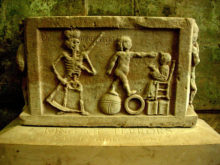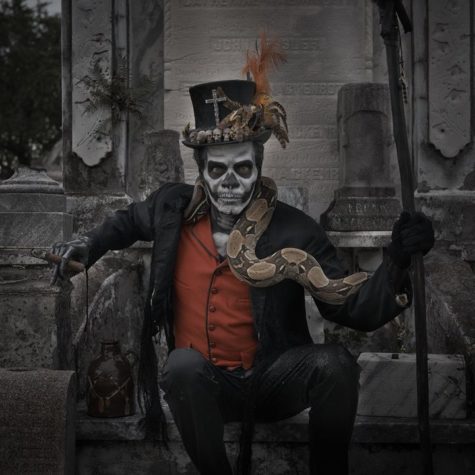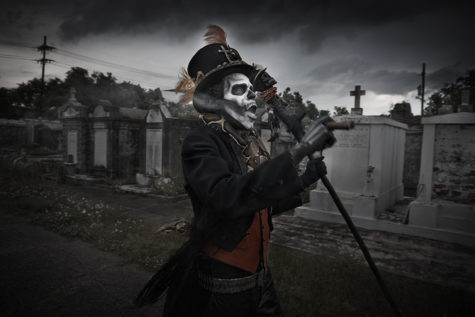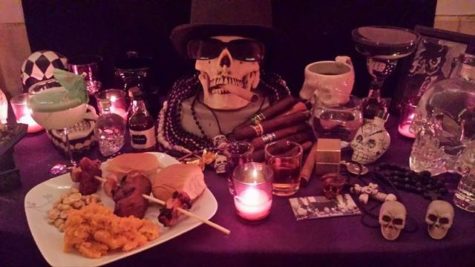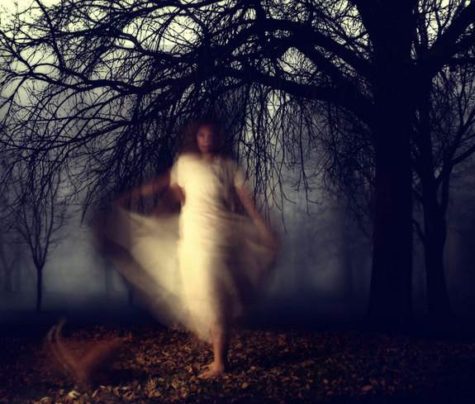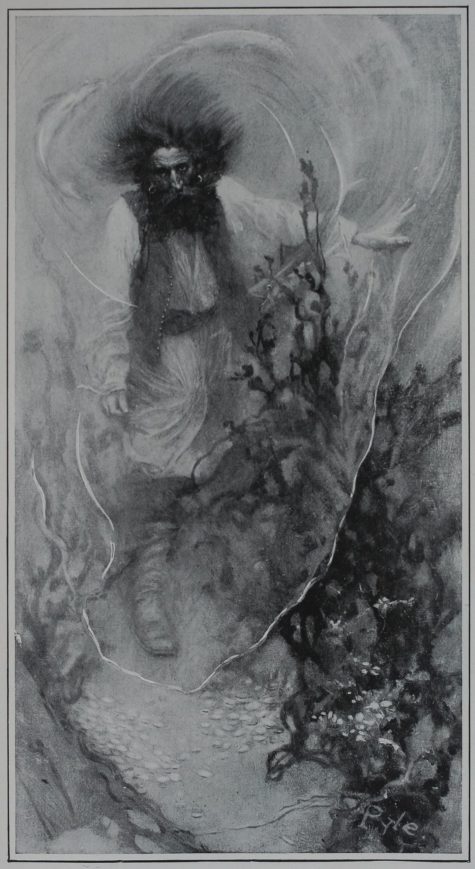Cemetery
The King of Terrors is among those spirits classified as Holy Death. He is closely related to the Grim Reaper. The King of Terrors is a skeleton bearing weapons. He may be crowned. He is a psychopomp but a fierce, scary one. His name says it all. He does not arrive bearing comfort or platitudes.
The name, King of Terrors, derives from the Book of Job 18:14:
“He is torn from the security of his tent
and marched before the King of Terrors.
Thus the King of Terrors is traditionally depicted driving dead souls before him. His image is carved onto tombstones and as ornamental motifs on medieval churches, most famously at Scotland’s Rosslyn Chapel.
Source: The Encyclopedia of Spirits
- Titles: Master of the Cemetery, Lord of the Dead
- Also known as: Bawon, Samedi, Bawon Sanmdi, Baron Saturday, Baron Sandi
- Colors: Black, also red and purple
- Day: Saturday
- Numbers: 3, 7, 21
- Classification: Lwa
- Consort: Madame Brigitte (Maman Brigitte)
- Venerated in: Haitian Vodou, Louisiana Voodoo, Folk Catholicism
- Feast: November 2
- Patronage: Death, tombs, gravestones, cemeteries, dead relatives, obscenities, healing, smoking, drinking, disruption, spirits
Baron Samedi is one of the loa of Haitian Vodou. He is the leader of the Barons and possibly the Gedes. He presides over a sprawling, confusing, complex clan of spirits. When people speak of the Baron, they tend to mean Baron Samedi. Baron Samedi literally means Baron Saturday, which may sound innocuous compared to Baron Cemetery, or Krininel, but Saturday was the one day when Christ was really truly dead, the day between the crucifixion on Friday and resurrection on Sunday. On Saturday, even Jesus must answer to the Baron, Lord of the Dead.
Baron Samedi is Grand Master of the Celestial Masonic Lodge of Vodou Spirits, a thirty-second degree initiated Mason. He is invoked to contact and communicate with the dead. He determines whether they can come visit or not. He may be petitioned to remove bothersome ghosts and invoked to ward off death.
He is noted for disruption, obscenity, debauchery, and having a particular fondness for tobacco and rum. Additionally, he is the loa of resurrection, and in the latter capacity he is often called upon for healing by those near or approaching death, as it is the only Baron who can accept an individual into the realm of the dead.
Baron Samedi spends most of his time in the invisible realm of vodou spirits. He is notorious for his outrageous behavior, swearing continuously and making filthy jokes to the other spirits. He is married to another powerful spirit known as Maman Brigitte, but often chases after mortal women. He loves smoking and drinking and is rarely seen without a cigar in his mouth or a glass of rum in his bony fingers.
Baron Samedi can usually be found at the crossroads between the worlds of the living and the dead. When someone dies, he digs their grave and greets their soul after they have been buried, leading them to the underworld.
He is a powerful healer and is especially sympathetic to terminally ill children. Baron Samedi rules the cemetery: no one can die until he gives permission for their grave to be dug. Baron Samedi is lewd, obscene, and vulgar, but he can be just and kind. He prefers that children live full lives before joining him in the cemetery.
Baron Samedi is the crossroads where sex and death meet. Spirit of the undying life-force, he may be petitioned for fertility. He is the guardian of ancestral knowledge and the link to your ancestral spirits. If one lens keeps popping out of your dark glasses, the Baron may be seeking your attention or offering his patronage.
Baron Samedi is syncretized to Jesus Christ as they share the symbol of the cross. It is possible that Baron Samedi’s associations with the cross may pre-date christianity. In Congolese cosmology, the cross is the symbol of the life cycle: death – birth – rebirth. He may also be syncretized to Saint Expedite, and with Saint Martin de Porres.
- Note:
Syncretized means to attempt to unite and harmonize especially without critical examination or logical unity.
Manifestations:
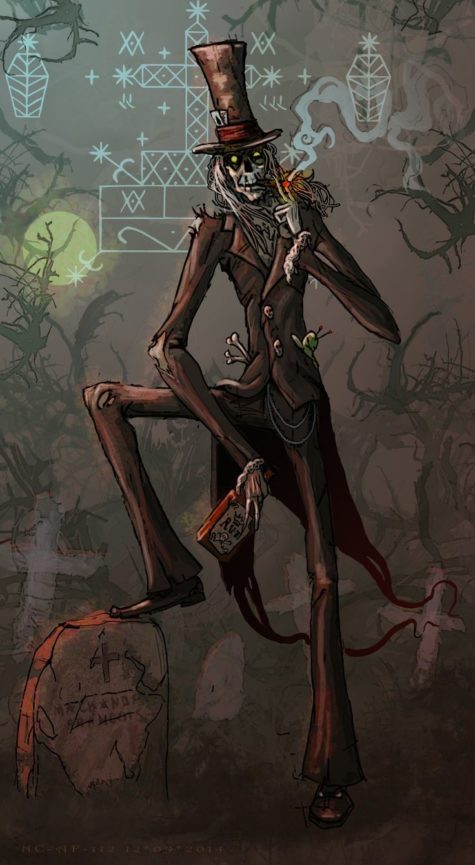 Baron Samedi manifests as an older, dark-skinned man in formal attire, dressed completely in black. He wears a black top hat, black suit, and may be smoking one of his beloved cigars. He wears impenetrable black sunglasses.
Baron Samedi manifests as an older, dark-skinned man in formal attire, dressed completely in black. He wears a black top hat, black suit, and may be smoking one of his beloved cigars. He wears impenetrable black sunglasses.
- The glasses may be missing a lens because he possesses two kinds of vision: he simultaneously sees the realms of the living and the dead.
- Alternatively his glasses have but one lens because a penis has but one eye and the phallus is his attribute (and because he loves sexual humor and innuendo.)
He is usually depicted with a top hat, black tail coat, dark glasses, and cotton plugs in the nostrils, as if to resemble a corpse dressed and prepared for burial in the Haitian style. He has a white, frequently skull-like face (or actually has a skull for a face), and speaks in a nasally voice. The former President for Life of Haiti, François Duvalier, modeled his cult of personality on Baron Samedi; he was often seen speaking in a deep nasal tone and wearing dark glasses.
- Favored People
Children; women seeking to conceive; funeral workers; grave diggers; those whose work brings them into contact with death.
Connection to other loas:
Baron Samedi is the leader of the Guédé, loa with particular links to magic, ancestor worship and death. Samedi is a loa of the dead, along with Baron’s numerous other incarnations Baron Cimetière, Baron La Croix, and Baron Kriminel. These lesser spirits, all dressed like the Baron, are all as rude and crude, but not nearly as charming as their master. They help carry the dead to the underworld.
Working with Baron Samedi
- Iconography: Baron Samedi’s throne is a chair chained to a cross. Images of Darth Vader are supposed to represent him (or just to decorate his altar; he likes toys)
- Attributes: Coffin; phallus, skull and crossbones; shovel; grave; black sunglasses; cross
As well as being master of the dead, Baron Samedi is also a giver of life. He can cure any mortal of any disease or wound, if he thinks it is worthwhile. His powers are especially great when it comes to vodou curses and black magic. Even if somebody has been afflicted by a hex that brings them to the verge of death, they will not die if the Baron refuses to dig their grave. So long as this mighty spirit keeps them out of the ground, they are safe.
He also ensures that all corpses rot in the ground to stop any soul from being brought back as a brainless zombie. What he demands in return depends on his mood. Sometimes he is content with his followers wearing black, white or purple clothes or using sacred objects; he may simply ask for a small gift of cigars, rum, black coffee, grilled peanuts, or bread. But sometimes the Baron requires a vodou ceremony to help him cross over into this world.
- Offerings
Black coffee, plain bread, dry toast, roasted peanuts. He drinks rum in which twenty-one very hot peppers have been steeped. Cigars, cigarettes, dark sun glasses, Day of the Dead toys, the sexier and more macabre the better; raise a skull and crossbones pirate flag for him, beautiful wrought-iron crosses are crafted in his honor.
- Veve
The veve or symbol for Baron Samedi is as follows:
Sources: Wikipedia and Encyclopedia of Spirits
The simplest definition of ghosts is that they are souls of the dead. Theoretically the word ghost encompasses all dead souls. However, dead souls who fade away and never reappear are memories, not ghosts. The word ghost implies that the dead soul maintains a presence in the realm of the living or perhaps refuses to leave.
Some ghosts may not realize they’re dead or may not know how to leave or where to go. In these cases, the living can intervene to help them transition via rituals, through shamans, or by requesting that a psychopomp escort the dead soul to safety.
Whether the presence of a ghost is intrinsically harmful is subject to debate. In some cultures, contact with ghosts is toxic to the living either because of mal-intent or just because contact with the dead is debilitating. Other cultures consider each ghost an individual case. Some are benevolent; some are lethal; others are just neutral presences having little effect one way or the other.
Some ghosts exhibit scary behavior, but many people find all ghosts frightening just because of their associations with death or the supernatural. No chain-clanking or nocturnal groaning is required; the ghost doesn’t actually have to do anything to cause fear other than be present.
Not all ghosts mean harm. Some simply enjoy lingering near the living. They do feed off human energy, tapping into the energy of individuals as if it were a power source: There’s a bit of a vampiric quality to this, but if not excessive it will not harm the average healthy individual. A ghost may actually be less energy-draining than some living “psychic vampires.”
Ghosts who linger without causing trouble can be tolerated. Some people enjoy the presence of ghosts. The reputed presence of ghosts is a selling point for many hotels, inns, and bed-and-breakfasts. Sensitive people can see ghosts, even if the ghosts don’t want to be seen. Put out an offering for them periodically. Make them feel welcome and this type of ghost can transform into an ally or be helpful in emergencies.
Some ghosts remain on the earthly plane because they are caught in a time warp: they constantly relive a tragedy that they experienced while alive. Some ghosts won’t leave because they have a mission. It may be to protect someone, to reveal information, or to seek revenge. Some ghosts are consumed with rage and resentment.
Raging ghosts who loathe and envy the living are dangerous ghosts. The most powerful can manifest in corporeal form and harm the living. Ghosts who are powerful enough to exert their individuality often transcend ghost status to become spirits. If honored and propitiated, even hostile ghosts can sometimes be persuaded to use their power benevolently.
Spirit mediums channel dead souls for benevolent purposes. Seances invite participation of dead souls so that they can provide information, comfort, and healing. Some dead souls, however, possess the living for their own selfish or destructive purposes. These must be exorcised or somehow made to leave.
Various spirits are renowned ghost busters. Sometimes even an image or amulet bearing their name is sufficient to send ghost packing. See the Ghost Busters page.
If a ghost can’t be exorcised, it can be distracted. Many ghosts, like low-level demons, demonstrate obsessive-compulsive behavior. Scatter tiny poppy or millet seeds. The ghost may feel compelled to pick up or count each and every one.
- Hanging up a many-holed sieve or fish net may have the same effect.
- Alternatively leave a ghost some thread and a needle with a broken eye. Some ghosts will spend eternity attempting to thread the needle, in the process, ceasing their depredations.
How someone died may effect what type of ghost they become. Allegedly those who die suddenly, violently, or before their time are more likely to become malevolent ghosts. In many parts of the world, the most feared ghost is a woman who died in childbirth. It’s crucial to point out, however, that not everyone who dies violently becomes a harmful ghost. Clearly most murder victims do not transform into rampaging supernatural beings, or there would be far less murder. It is not entirely clear why some victims of violent crimes turn into benevolent helpers while others become utterly consumed with rage and anger toward the entire world.
Various botanicals are said to discourage the presence of ghosts, especially rue and garlic. See the post on Ghost Busting with Botanicals for a more extensive list.
From: Encyclopedia of Spirits
A revenant is an animated corpse typically possessed by a spirit that was believed to return from the grave to terrorize the living. The word “revenant” is derived from the Latin word, revenans, “returning” (see also the related French verb “revenir”, meaning “to come back”).
Vivid stories of revenants arose in Western Europe (especially Great Britain, and were later carried by Anglo-Norman invaders to Ireland) during the High Middle Ages. Though later legend and folklore depicts revenants as returning for a specific purpose (e.g., revenge against the deceased’s killer), in most Medieval accounts they return to harass their surviving families and neighbors. Revenants share a number of characteristics with folkloric vampires.
Many stories were documented by English historians in the Middle Ages. William of Newburgh wrote in the 1190s,
“It would not be easy to believe that the corpses of the dead should sally (I know not by what agency) from their graves, and should wander about to the terror or destruction of the living, and again return to the tomb, which of its own accord spontaneously opened to receive them, did not frequent examples, occurring in our own times, suffice to establish this fact, to the truth of which there is abundant testimony.”
Stories of revenants were very personal, always about a specific individual who had recently died (unlike the anonymous zombie depicted in modern popular culture), and had a number of common features.
Source: Wikipedia

